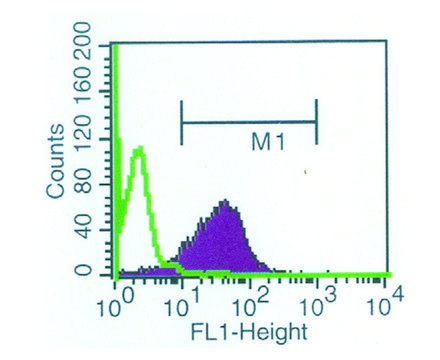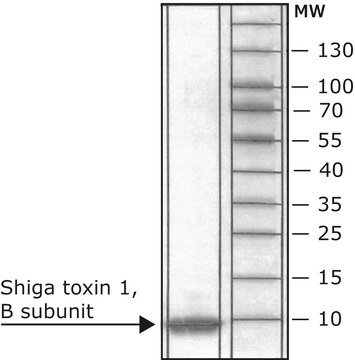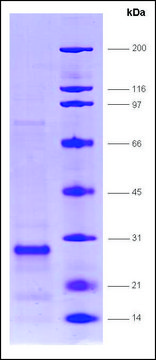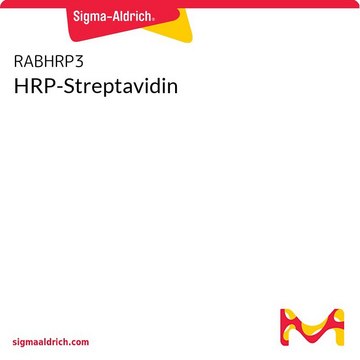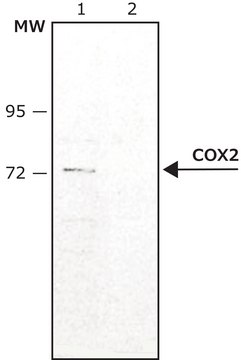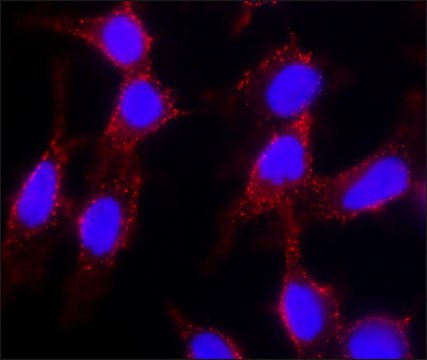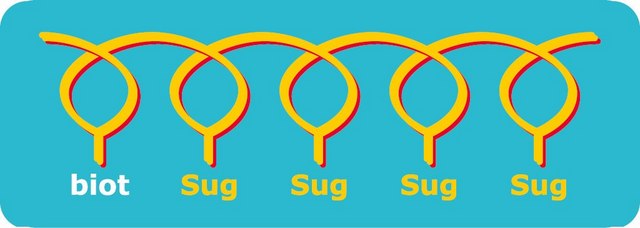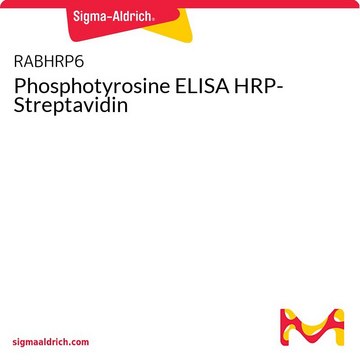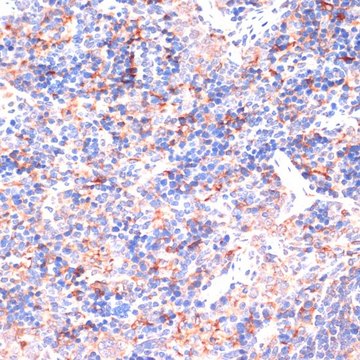SAB4200774
Anti-Shiga Toxin 1, B Subunit (STxB) antibody, Mouse monoclonal
clone 13C4, purified from hybridoma cell culture
别名:
Anti-SLT-1 B subunit, Anti-SLT-1b, Anti-Shiga-like toxin 1 subunit B, Anti-Verocytotoxin 1 subunit B, Anti-Verotoxin 1 subunit B, Anti-stxB
登录查看公司和协议定价
所有图片(2)
About This Item
UNSPSC代码:
12352203
NACRES:
NA.43
推荐产品
生物来源
mouse
质量水平
抗体形式
purified from hybridoma cell culture
抗体产品类型
primary antibodies
克隆
13C4, monoclonal
描述
Research area: Microbiome
表单
buffered aqueous solution
分子量
~7 kDa
种属反应性
E. coli
浓度
~1.0 mg/mL
技术
flow cytometry: 2.5-5 μg/test using human RAMOS cells pretreated with recombinant Shiga toxin 1, B subunit
immunoblotting: 1-2 μg/mL using purified recombinant Shiga Toxin 1-B subunit produced in E. coli (using PVDF membrane)
immunoprecipitation (IP): suitable
同位素/亚型
IgG1
UniProt登记号
运输
dry ice
储存温度
−20°C
靶向翻译后修饰
unmodified
一般描述
Monoclonal Anti-Shiga Toxin 1, B Subunit (mouse IgG1 isotype) is derived from the 13C4 hybridoma, produced by the fusion of mouse myeloma cells and splenocytes from BALB/c mouse immunized with a purified Shiga-like toxin from E. coli H30. Shiga toxins consist of two polypeptides, an A chain and a B chain non-covalently associate with an apparent stoichiometry of one A and five B chains to form the holotoxin.
The Shiga toxins are a family of related protein toxins secreted by certain types of bacteria. Shiga toxin (Stx) is produced by Shigella dysenteriae; whereas, the Shiga-like toxins, Stx1 and Stx2, with a few known isoforms, are secreted by specific strains of Escherichia coli named Shiga-toxin-producing E. coli (STEC) such as E. coli O157:H7. The latter may cause bloody diarrhea and hemorrhagic colitis in humans, which may lead to fatal systemic complications.
特异性
Monoclonal Anti-Shiga Toxin 1, B Subunit antibody specifically recognizes the B subunit of Shiga holotoxin.
免疫原
purified Shiga-like toxin from E.coli H30
应用
Anti-Shiga Toxin 1, B Subunit (STxB) antibody, Mouse monoclonal has been used in:
- immunoblotting
- flow cytometry
- immunoprecipitation
生化/生理作用
Shiga-toxin (Stx) produced by E. coli O157:H7 may cause bloody diarrhea and hemorrhagic colitis in humans, which may lead to fatal systemic complications. All the Stx isoforms have similar structure and mechanism of action. The catalytic A subunit has RNA N-glycosidase activity that inhibits eukaryotic protein synthesis. The B subunits form a pentamer, which recognizes and binds to the functional cell-surface receptor globotriaosylceramide [Gb3, Gala(1-4)-Galb (1-4)-Glcb1-ceramide]. Gb3 is overexpressed in membranes of numerous tumor cells, Therefore, STxB binding to Gb3 receptors may be useful for cell-specific vectorization, labeling, and imaging purposes.
外形
Solution in 0.01 M phosphate buffered saline, pH 7.4, containing 15 mM sodium azide as a preservative.
其他说明
This product is for R&D use only, not for drug, household, or other uses.
未找到合适的产品?
试试我们的产品选型工具.
储存分类代码
10 - Combustible liquids
闪点(°F)
Not applicable
闪点(°C)
Not applicable
法规信息
常规特殊物品
历史批次信息供参考:
分析证书(COA)
Lot/Batch Number
In vivo tumor targeting by the B-subunit of shiga toxin
Viel T, et al.
Molecular Imaging, 7(6), 7290-2008 (2008)
Shiga toxin and its use in targeted cancer therapy and imaging
Engedal N, et al.
Microbial Biotechnology, 4(1), 32-46 (2011)
Human colorectal tumors and metastases express Gb3 and can be targeted by an intestinal pathogen-based delivery tool
Falguieres T, et al.
Molecular Cancer Therapeutics, 7(8), 2498-2508 (2008)
Shiga toxin: purification, structure, and function
Donohue-Rolfe A, et al.
Reviews of Infectious Diseases, 13, S293-S297 (1991)
我们的科学家团队拥有各种研究领域经验,包括生命科学、材料科学、化学合成、色谱、分析及许多其他领域.
联系技术服务部门